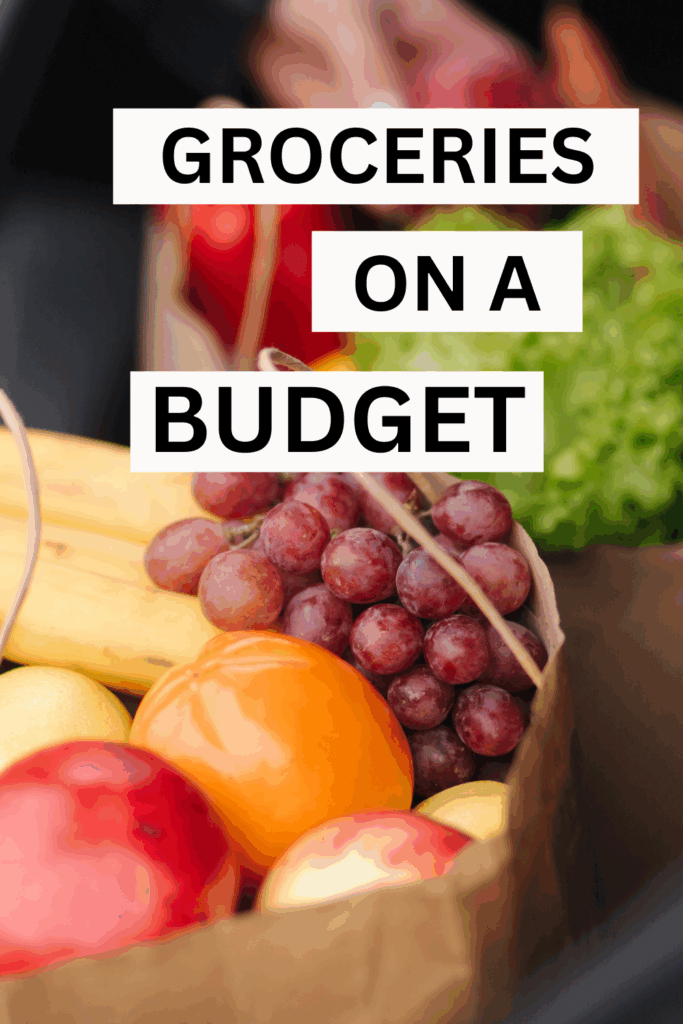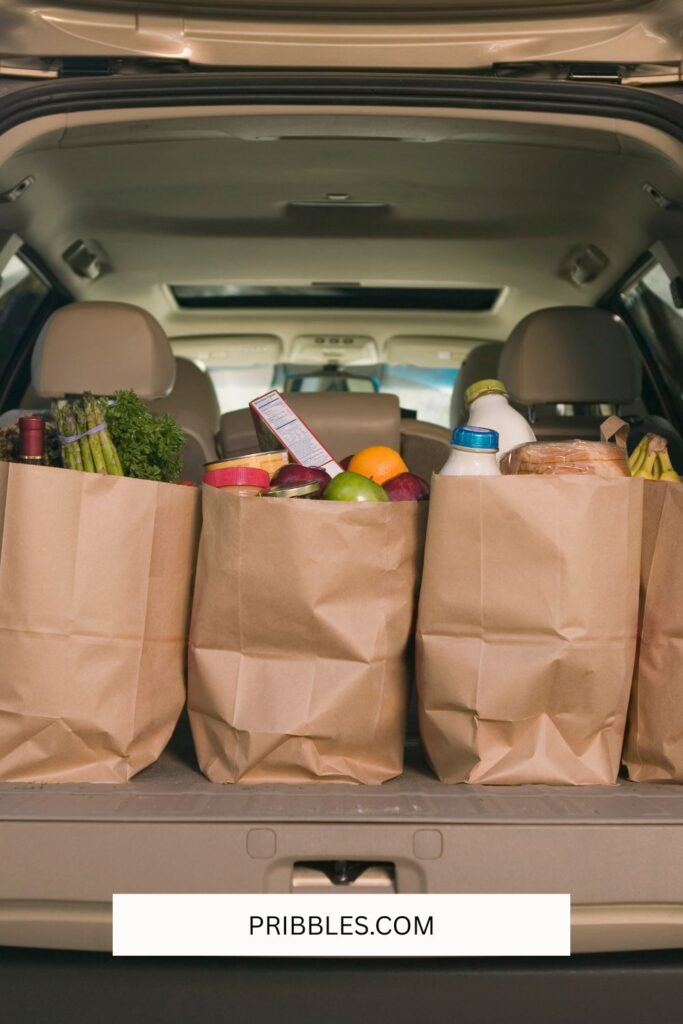Groceries on a Budget: Simple Tips for Moms Who Want to Save Without Stress
Groceries. They’re one of those unavoidable expenses that always seem to sneak up on us. You head into the store with a short list, and somehow leave with a cart full of snacks, a candle you didn’t plan on, and a bill that makes you gasp a little at checkout. Friend, you are not alone—I’ve been there too.
Save for later

Affiliate links may be used in this post and if so I will receive a commission at no extra cost. I’m also part of the Amazon Affiliate (Associate) program where I earn a commission from sales made through my affiliate links. Read the full disclosure policy.
As a stay-at-home mom, the grocery budget can feel like one of the few areas we actually can control, but it often feels like it slips through our fingers. The good news? With some planning, creativity, and a few cozy mom hacks, you can absolutely get your groceries under control without sacrificing the meals and snacks your family loves.
Let’s talk about realistic, practical ways to save money on groceries without adding stress to your already full plate.

Why Groceries Are So Tricky
Before we dive into tips, let’s be real for a moment. Grocery spending can spiral for a few reasons:
- Impulse buys: Those “oh, this looks good” items add up quickly.
- Convenience foods: Easy meals save time, but cost more.
- Kids’ appetites: Snacks disappear like magic in a house full of little ones.
- Lack of planning: No list = random (and expensive) purchases.
Sound familiar? The good news is, once you know where your grocery money is going, you can put a plan in place to rein it in.
10 Tips for Buying Groceries on a Budget
1. Start with a Realistic Budget
First things first: know your number. How much can your family actually afford to spend on groceries each week or month?
Look at your income and expenses, and set a budget that fits. Writing it down helps you stay accountable. Think of it like setting guardrails—it keeps you from overspending without you even realizing it.
Once you know your number, you can plan meals, make shopping lists, and even decide which store trips fit best into your budget. And don’t be afraid to adjust as you go—sometimes it takes a month or two to figure out the sweet spot that really works for your family.
2. Meal Plan Around What You Have
Before you shop, look through your pantry, fridge, and freezer. Build meals around what you already own. If you’ve got pasta and canned tomatoes, spaghetti is halfway done. This prevents wasted food and wasted money.
Take 10 minutes each week to create a meal plan—just a simple one with dinners listed out. It doesn’t need to be fancy or color-coded; even a note on the back of an envelope works. When you start with what you have, you’re reducing waste and making sure money you’ve already spent doesn’t go to waste.
Pro tip: Keep a running list of what’s in your freezer so you don’t forget about those chicken breasts hiding in the back.
3. Shop with a List (and Stick to It!)
I know it sounds obvious, but making a list—and actually following it—is one of the most powerful ways to save. Plan your meals, write down what you need, and don’t stray. If it’s not on the list, it doesn’t go in the cart.
When you go to the store without a list, you’re letting the store make decisions for you, and spoiler: the store’s goal is to get you to spend more. A list keeps you in charge. To make it even easier, save your lists digitally in an app or in your notes so you can reuse them week after week.
4. Embrace Store Brands
Generic or store-brand items are often just as good as name brands, and much cheaper. Try swapping out just a few items each week—you’ll hardly notice the difference, but your wallet will.
Start small with pantry staples like flour, sugar, pasta, or canned veggies. Once you see how much you’re saving, branch out into other areas like cleaning supplies or frozen items. Over time, these small swaps add up to big savings.
5. Buy in Bulk (When It Makes Sense)
Some items, like rice, beans, oats, and even certain meats, are cheaper when bought in larger quantities. Just be sure it’s food your family will actually eat before it expires.
If you have the storage space, buying in bulk can be a huge money-saver. Think about dividing items up into smaller containers once you get home. For example, buy a family pack of chicken, then portion it into freezer bags for multiple meals. This way, you’re saving money and saving time on busy nights.
6. Shop the Sales and Stock Up
Keep an eye on weekly ads from your local store. When something you use regularly goes on sale—like ground beef, pasta, or cereal—buy extra and store it. Stocking up now saves you from paying full price later.
The trick is not to buy things just because they’re on sale, but to stock up on items you know you’ll actually use. If spaghetti sauce is 50% off and your family eats pasta weekly, it makes sense to grab several jars. That’s future savings in your pantry.
7. Cook from Scratch (as Much as You Can)
Pre-packaged meals and snacks are convenient but expensive. Cooking simple meals from scratch—like soups, casseroles, or homemade bread—can save a ton. Start small: maybe swap out store-bought muffins for homemade once a week.
Cooking from scratch doesn’t mean you have to spend hours in the kitchen. A pot of soup or a big batch of chili can come together quickly and feed your family for several meals. Not only does it save money, but it also gives you control over the ingredients, which is often healthier too.
8. Use Cash or Grocery Pickup
If you’re prone to impulse buys, try grocery pickup—it keeps you from wandering the aisles. Or, use cash envelopes for groceries. When the cash is gone, you’re done shopping. Both methods help you stay within your budget.
Pickup also allows you to see your total before you hit “submit,” giving you the chance to edit your cart if it’s over budget. With cash, there’s something powerful about physically handing over money—it makes you think twice before tossing extra items in.
9. Limit Trips to the Store
Every extra trip = extra temptation. Plan one big shopping trip each week (or every two weeks) instead of popping in every other day. Fewer trips means fewer opportunities to overspend.
The more often you shop, the more likely you are to grab extras you don’t need. Planning ahead for fewer trips encourages better meal planning, smarter shopping, and fewer budget-busting “just one thing” runs.
10. Don’t Shop Hungry
Trust me, everything looks delicious when your stomach is growling. Eat before you go and you’ll make smarter, less impulsive choices.
This simple step can save you a surprising amount of money. Shopping on a full stomach makes it easier to resist impulse snacks, bakery treats, or takeout when you get home because you’re “too tired” to cook.
Bonus Hacks for Moms
- Snack Baskets: Pre-portion snacks into baskets so kids know what’s available each day. It prevents snack overload and helps groceries stretch further.
- Meatless Meals: Try one or two meat-free dinners a week (like veggie stir fry, beans and rice, or pasta primavera). Meat is one of the priciest items on your list.
- Seasonal Produce: Fruits and veggies in season taste better and cost less. Shop local farmers’ markets at the end of the day for deals.
- Leftover Nights: Once a week, make a “clean out the fridge” meal. It reduces waste and saves money.

Building a Cozy, Budget-Friendly Kitchen
Here’s the truth: feeding your family on a budget doesn’t have to feel like deprivation. It’s not about saying “no” all the time—it’s about being intentional. You can still create meals that feel comforting, cozy, and delicious without blowing your budget.
Some of my family’s favorite budget-friendly meals:
- Slow cooker chili with cornbread.
- Breakfast-for-dinner (pancakes, eggs, fruit).
- Homemade pizza night with simple toppings.
- Soup with grilled cheese sandwiches.
These meals are cheap, filling, and cozy—all while keeping the grocery budget in check.
Final Thoughts
Groceries will always be a part of life, but they don’t have to drain your wallet. With a little planning, some simple swaps, and a dash of creativity, you can feed your family well while sticking to a budget that works for you.
Remember, friend, progress matters more than perfection. Even shaving $20 off your weekly grocery bill adds up to over $1,000 a year—that’s a vacation fund, a debt payment, or simply breathing room in your budget.
So next time you head to the store, go in with confidence. You’ve got a plan, and you’re building not just meals—but peace of mind, one grocery trip at a time.







